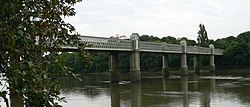Kew Railway Bridge | |
|---|---|
 Kew Railway Bridge | |
| Coordinates | 51°29′02″N0°16′46″W / 51.4839°N 0.2794°W |
| Carries | North London Line of the London Overground London Underground District line |
| Crosses | River Thames |
| Locale | Kew |
| Maintained by | Network Rail |
| Heritage status | Grade II listed structure [1] |
| Characteristics | |
| Design | Lattice girder [1] |
| Material | Wrought iron |
| Total length | 575 feet |
| No. of spans | 5 |
| History | |
| Designer | W. R. Galbraith [2] [1] |
| Opened | 1 January 1869 [1] |
| Statistics | |
Listed Building – Grade II | |
| Official name | Kew Railway Bridge |
| Designated | 25 May 1983 |
| Reference no. | 1065412 |
| Location | |
 | |

Kew Railway Bridge spans the River Thames in London, England, between Kew and Strand-on-the-Green, Chiswick. The bridge was opened in 1869. [1]


